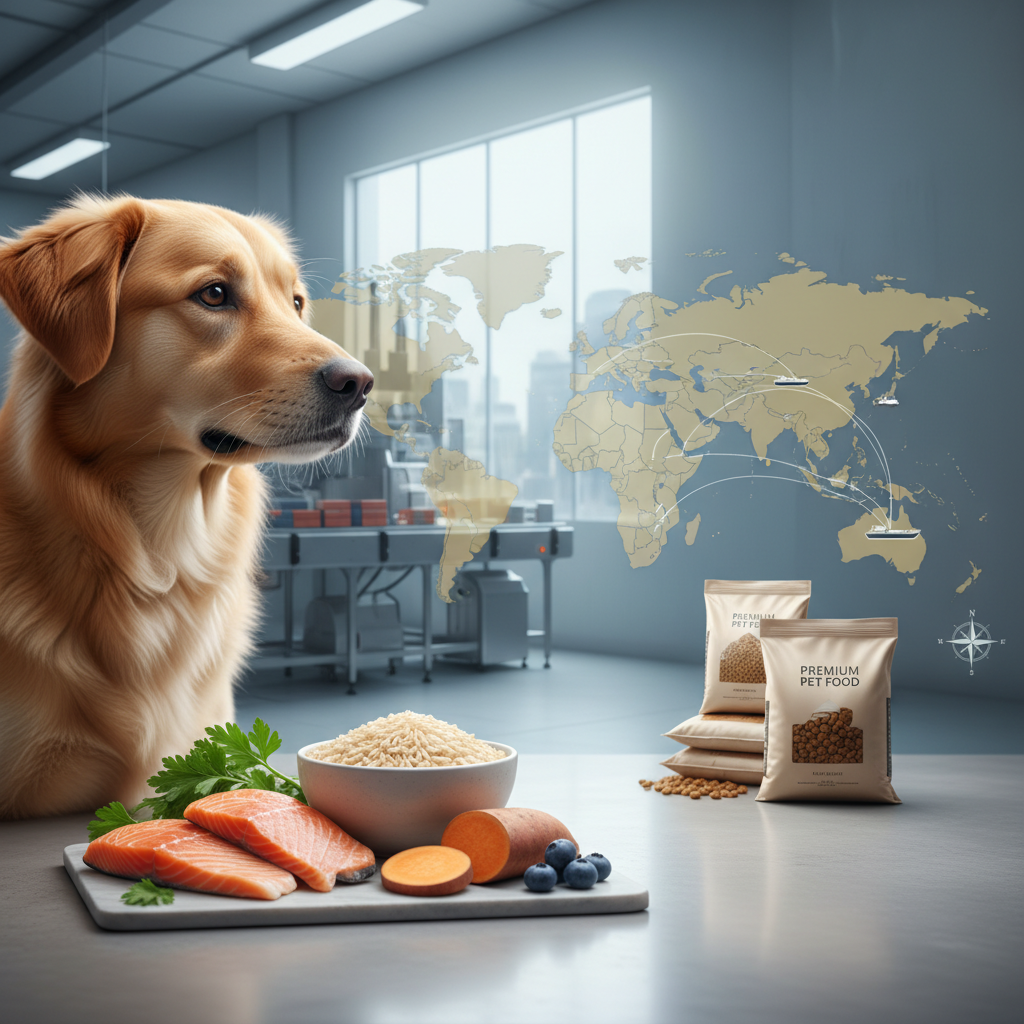

Unleashing Potential: A B2B Guide to Private Label Dog Food Manufacturing and Export in Southeast Asia
The global pet food industry is experiencing remarkable growth, particularly in the dynamic markets of Southeast Asia. With rising disposable incomes, increasing pet ownership, and a growing humanization of pets, the demand for high-quality dog food is skyrocketing. For B2B players – whether you're an importer, distributor, wholesaler, or an aspiring private label brand owner – this region presents an unparalleled opportunity. Navigating the complexities of manufacturing and exporting private label dog food can be challenging yet incredibly rewarding. This comprehensive guide will equip you with the insights and actionable strategies needed to thrive in the competitive Southeast Asian pet food landscape, focusing on quality, compliance, and strategic market entry.
The Rise of Private Label Dog Food in Southeast Asia
Southeast Asia, a region of rapidly developing economies, is a mosaic of diverse cultures with unique consumer preferences. The pet care market here is burgeoning, driven by urbanization and a shift in how pets are perceived – from mere animals to cherished family members. This cultural evolution fuels a demand for premium, specialized, and trustworthy pet food options, making private label brands an attractive proposition.
Why Private Label? Understanding the Market Advantage
Private labeling offers distinct advantages for businesses looking to enter or expand within the pet food sector. It allows companies to establish their own brand identity, control product specifications, and often achieve higher profit margins. In a diverse region like Southeast Asia, private label flexibility enables brands to tailor products to specific local tastes, dietary needs, or economic segments, fostering stronger brand loyalty and market penetration. It’s about creating and owning a niche, from ingredient sourcing to shelf presence.
Key Market Trends in Southeast Asia
Understanding the market pulse is crucial. Key trends shaping the dog food industry in Southeast Asia include:
- Premiumization and Natural Ingredients: Consumers seek natural, organic, and limited-ingredient diets. Grain-free, high-protein, and locally sourced ingredient claims resonate strongly.
- Health and Wellness Focus: Functional foods addressing specific health concerns (e.g., digestive, joint, skin & coat) are gaining traction.
- E-commerce Dominance: Online sales channels are indispensable, offering convenience and wider selection.
- Sustainability and Ethical Sourcing: A growing segment values eco-friendly packaging and ethically sourced ingredients.
- Local Flavors: Incorporating or highlighting local ingredients can create a unique selling proposition.
Navigating the Private Label Dog Food Manufacturing Process
The journey from concept to marketable product requires meticulous planning and adherence to stringent quality standards. Partnering with the right manufacturing facility is paramount for private label success.
Raw Material Sourcing: Quality and Compliance are Key
The foundation of high-quality dog food lies in its ingredients. For exports to Southeast Asia, sourcing must consider nutritional value and regulatory compliance in target markets.
- Protein Sources: High-quality animal proteins (chicken, beef, lamb, fish) are essential. For certain regions, novel proteins or sustainable alternatives might be appealing. Ingredients like buffalo meat or buffalo Omasum offer lean, protein-rich options, provided they meet all import regulations.
- Other Key Ingredients: Quality grains/starches (rice, corn, peas), healthy fats/oils (chicken fat, salmon oil), and a balanced blend of vitamins and minerals are vital. Natural preservatives and palatability enhancers should comply with local regulations.
- Supplier Vetting: Establish robust supplier qualification programs, including audits and regular quality checks, ensuring consistent ingredient quality and safety. Traceability is increasingly demanded.
Formulation and Product Development: Meeting Regional Demands
Developing a winning formula requires understanding nutritional science, pet dietary needs, and regional consumer preferences.
- Nutritional Balance: Formulations must meet AAFCO or FEDIAF nutrient profiles for relevant life stages.
- Ingredient Specificity: Tailor ingredients to local availability and cultural acceptance.
- Palatability Testing: Extensive testing ensures the product is not just nutritious but also highly appealing.
- Packaging Design: Consider local language, cultural symbols, and practical aspects like resealability.
Manufacturing Standards and Quality Control
Impeccable manufacturing standards are non-negotiable for success in global trade.
- GMP and HACCP: Adherence to Good Manufacturing Practices (GMP) and Hazard Analysis and Critical Control Points (HACCP) is fundamental for food safety and quality.
- Facility Certification: Look for manufacturers with internationally recognized certifications (e.g., ISO, BRCGS).
- Batch Consistency: Implement rigorous quality control checks at every stage, from raw material inspection to finished product analysis.
- Traceability: A robust traceability system allows for quick identification and recall, protecting brand reputation.
Exporting Private Label Dog Food to Southeast Asia: A Strategic Play
Exporting to diverse markets like Southeast Asia demands a well-thought-out strategy addressing regulatory hurdles, logistics, and market nuances.
Regulatory Compliance and Certification
Each country in Southeast Asia has its own import regulations, labeling requirements, and health certificates.
- Country-Specific Regulations: Research specific import requirements for each target country (e.g., Vietnam, Thailand, Malaysia). These vary significantly.
- Veterinary Health Certificates: Most countries require certificates from the exporting country's government, confirming product safety and origin.
- Labeling Laws: Pay close attention to language requirements, nutritional declarations, ingredient lists, and allergen warnings specific to each market.
- Ingredient Restrictions: Be aware of any prohibited ingredients or specific processing requirements for animal-derived products.
Supply Chain Optimization for Export Success
An efficient and resilient supply chain is the backbone of any successful export operation.
- Logistics Planning: Choose reliable shipping partners experienced in international foodstuff logistics. Consider transit times, temperature control, and customs clearance.
- Warehousing and Distribution: For larger volumes, consider local warehousing or partnering with local distributors.
- Inventory Management: Implement robust systems to minimize waste and ensure product freshness.
- Risk Mitigation: Develop contingency plans for potential disruptions.
Packaging and Labeling for International Markets
Beyond regulatory compliance, packaging plays a critical role in market appeal and product preservation.
- Durability for Transit: Packaging must withstand the rigors of international shipping.
- Market Appeal: Design packaging that resonates with local culture and consumer aesthetics, clearly communicating brand values.
- Information Clarity: All mandatory information must be clearly legible and accurate in the local language(s).
- Sustainability: Incorporate sustainable packaging solutions where feasible.
Partnering for Success: Choosing the Right Manufacturer
Selecting a private label dog food manufacturer is one of the most critical decisions. This partner will be an extension of your brand, directly impacting product quality and market success.
Checklist for Selecting a Private Label Manufacturer
To ensure you choose a partner aligned with your business goals:
- Experience and Expertise: Proven track record in private label pet food production and exports.
- Certifications and Compliance: Adherence to international food safety standards (ISO, HACCP, GMP) and experience with export regulations for Southeast Asia.
- Raw Material Sourcing: Reliable and traceable sourcing for high-quality ingredients, including specialized options like buffalo meat or buffalo Omasum.
- Formulation Capabilities: Ability to develop or customize formulations to meet specific nutritional profiles and market trends, with R&D support.
- Production Capacity and Flexibility: Ability to meet volume requirements and flexibility for different batch sizes.
- Quality Control Procedures: Robust internal quality control and assurance processes.
- Packaging and Labeling: Capability to handle diverse packaging formats and multi-language labeling.
- Logistics Support: Assistance with export documentation and logistics.
- Communication and Transparency: Responsive, transparent, and willing to build a long-term partnership.
- Cost-Effectiveness: Competitive pricing offering good value.
Conclusion:
The private label dog food market in Southeast Asia offers immense opportunity. By understanding regional trends, meticulously planning your manufacturing and export strategy, and forging strong partnerships with experienced manufacturers, you can confidently launch and grow your brand. From ensuring the highest quality raw materials like lean buffalo meat to navigating complex regulatory frameworks, every step requires precision and foresight. Success in this dynamic region hinges on a commitment to quality, adaptability to local tastes, and a robust, compliant supply chain. Embrace the journey to unleash significant potential for your business.
Call to Action:
Ready to explore private label dog food opportunities in Southeast Asia? Partner with an experienced manufacturer that understands global trade, quality raw materials, and regional market needs. Contact us today to discuss how we can help bring your private label dog food brand to life and expand your reach in the thriving Southeast Asian market.


